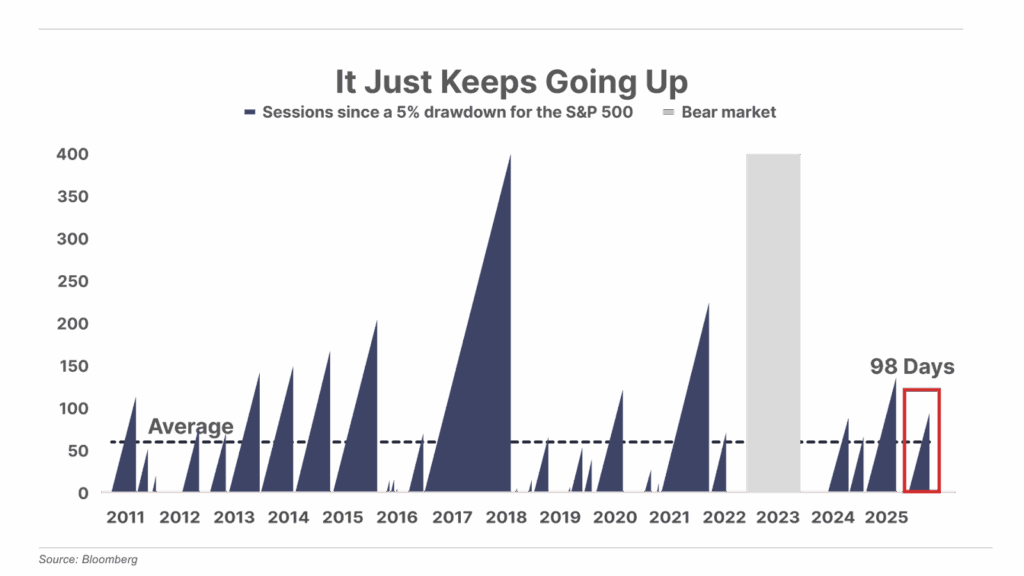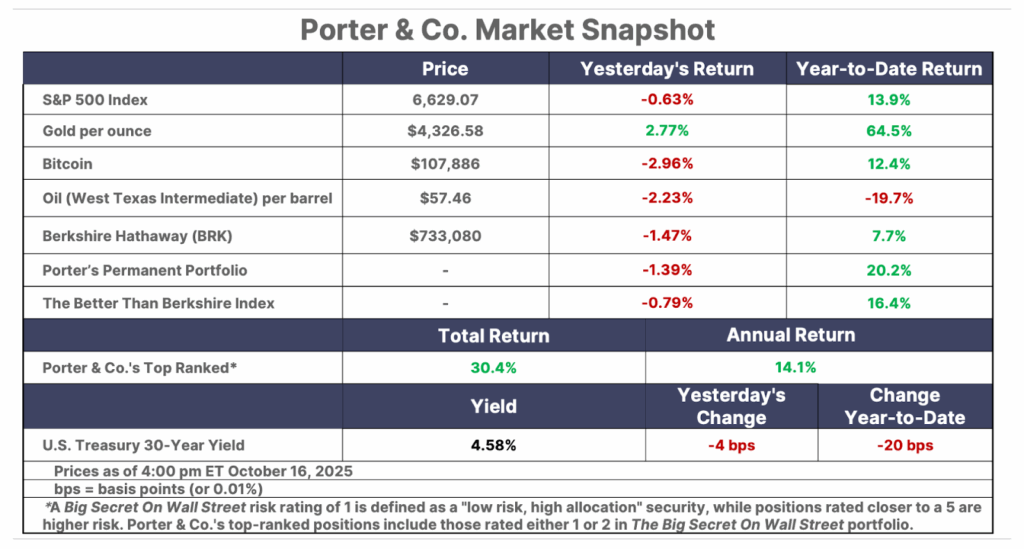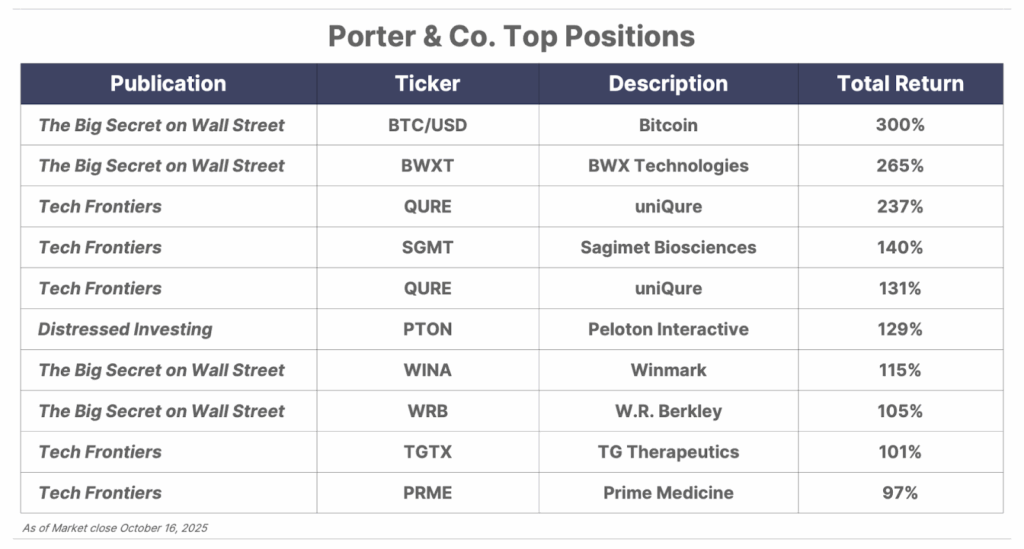Issue #120, Volume #2


How The Media Manipulates The Public Into War
This is Porter’s Daily Journal, a free e-letter from Porter & Co. that provides unfiltered insights on markets, the economy, and life to help readers become better investors. It includes weekday editions and two weekend editions… and is free to all subscribers.
| An ear for an ear… Finding ways to need a war… Spanish slaves… Profitable sugar… Kuwait needed an ear… Why P&C stocks are slumping… |
Editor’s note: The market is fixated on some obvious problems in the credit markets – office commercial real estate, subprime auto lending, etc. These issues aren’t new, and they will be fixed with more printing – like all credit problems in a paper economy. Meanwhile, our subscribers are also frustrated with the poor performance of our property and casualty (P&C) stocks this year, compared to everything else that’s ripping higher.
In our minds, these are “normal” problems, and, unfortunately, we know many of you will overreact and abandon a winning strategy. Stay the course. And, if you want something to worry about… then worry about things that matter. Like Jenkin’s ear.
Let me explain…
My concern isn’t a 10% correction in the S&P 500. And it’s not lower interest income in our P&C portfolio. It isn’t even a 50% correction in Bitcoin or a badly needed pull back in gold. My concern is the things our government has been doing – things that we haven’t seen since the 1930s.
A government that’s desperate to avoid a default will always do three things.
- They print money. That’s been going on ever since the Global Financial Crisis bailouts doubled the national debt in 2009. It was this debt monetization that launched my first warnings (The End Of America) that our country was heading down a very dangerous path.
- The next mile marker on the road to national perdition is erecting tariffs. While tariffs can easily be sold to the public, they are devastating to our economy. They always wipe our farmers. And they will cause a huge increase to consumer prices, as they disrupt global supply chains. Paying more for things like steel, clothing, wood, and cars doesn’t make us richer. Every economist understands this sophistry. Free markets create vast wealth. Governments (and their taxes, including tariffs) squander enormous wealth.
- And as the impact of these policies is felt (higher inflation, less economic growth, a collapse in real per capita GDP, lower living standards) a scapegoat will be found. Just like with Jenkin’s ear.
And there will be a war. If you go back through American history, you’ll find this pattern is always the same. What led to the Spanish-American War? The financial crisis of 1893. What led to America’s involvement in World War I? The Panic of 1907, which led to the Federal Reserve (1913) and the ability to finance a global war. What led to WWII? The Great Depression and the Smoot-Hawley Tariff Act.
When the elites’ financial dominance is threatened, they will find an ear. And they will cut it off.
The medical term is traumatic auriculectomy.
That’s, technically, what happened to British sea captain Robert Jenkins. He got his ear cut off by Spanish customs officials near the coast of Cuba in 1731. But what happened next is one of history’s prime examples of how elites convince the public to go to war.
The War Of Jenkins’ Ear
In 1713, the Treaty of Utrecht brought an end to France’s domination of Europe. A new peace for Europe, based on Spanish dominance, was established.
Of top importance was Spain’s decision to assign the Asiento de Negros to the British, instead of to the French.
The Asiento was a 30-year license to supply 5,000 African slaves to the Spanish empire each year.
In the pre-industrial world, wealth was created by either exploiting land (timber, farming) or labor (slavery). The most profitable way to exploit land and labor was sugar plantations. And the largest, and most valuable, sugar plantations were in Spain’s new world colonies.
How much money are we talking about?
For the British, the value of sugar from Jamaica – one small island – was worth more than all the trade from its 13 North American colonies, combined. A single 200-acre sugar plantation was enough to support the lifestyle of the wealthiest aristocrat in London. The value of Spanish sugar production in the new world was a substantial portion of global GDP at the time.
What did the sugar plantations need in order to function? They needed slaves. The Asiento was a monopoly on the slave trade for all of Spain’s territories in the new world. And that’s not all. The Asiento also conveyed the right to 500 tons of additional duty-free trade with the Spanish colonies. Thus, the Asiento was the world’s most valuable license in the 1720s.
Britain’s South Sea Company had already been established (in 1711) as a public-private partnership to control the monopoly on trade with Britain’s colonies in the Caribbean. Further British bribes ensured that the Asiento was granted to the South Sea Company. The license was so valuable that after the Asiento was granted to the company, the British government began to swap large amounts of its national debt for shares.
In this way, most of Britain’s leading politicians and its wealthiest families became tied, directly, to the success of trade with Spain.
The money, however, wasn’t in slaves. It was in sugar. Slave trading, via the Asiento, was just the legal cover to get British ships into Spanish ports. All of the real money was made smuggling sugar.
Smuggling sugar was so profitable that it was impossible to stop. The Spanish even shut down the entire slave trade for two years between 1727 and 1729 because sugar smuggling was endemic. They didn’t resume the slave trade until the Treaty of Seville (1729), which granted Spanish customs agents the authority to board British vessels to check for contraband.
But… did that stop the British from smuggling? No.
Robert Jenkins’ ship was loaded with sugar. And when he fought against the Spanish agents, who were attempting to seize his vessel, he lost an ear.
At the time – 1731 – nobody cared much about poor Robert Jenkins. The loss of his ear was just the cost of doing business. Nothing came of the matter. The smuggling and the South Sea Company’s obstinate refusal to abide by the terms of the Asiento continued. Likewise, the Spaniards continued to retaliate by seizing the ships and the cargo of the smugglers they caught.
Finally in 1739, at the Convention of Prado, the British and the Spanish agreed to avoid outright war. They settled a boundary dispute between Georgia and Florida. And they agreed that the South Sea Company would pay Philip V (the King of Spain) £68,000, which it owed according to the Asiento.
What do you think happened next?
This agreement would have avoided bloodshed. It merely demanded that the British pay a reasonable amount for the privilege of their monopoly. But the agreement, if abided by, would have severely damaged the South Sea Company… whose shareholders were among the most powerful and wealthy people in Britain.
So the powerful members of the South Sea Company used the media to stir up the public against the Spanish. And the PR campaign had a central focus – Robert Jenkins’ ear.
Jenkins presented his ear, kept pickled in a jar, to Parliament at the apex of the media coverage. The media proceeded to demand “an ear for an ear.” Jenkins was widely interviewed. According to the papers, he kept saying things like “I regret that I only have one ear to give for my country.” No one mentioned that he’d lost his ear almost a decade earlier… in part because he was breaking the law.
Meanwhile, Britain’s Prime Minister, Sir Robert Walpole, who knew all of this stuff was nonsense, tried in vain to keep his country out of a senseless war. It was no use: the Navy and the owners of the South Sea Company had too much to gain from violence.
The War of Jenkins’ Ear began.
And it was an absolute catastrophe.
Among the losses was the failed 67-day siege of Cartagena.
Admiral Vernon took 200 ships to plunder one of Spain’s most valuable colonies. He was badly defeated and lost 10,000 men to yellow fever.
The other major thrust of the war – stealing Spain’s treasure fleet as it sailed from Acapulco to Manilla in the Philippines – was an even bigger disaster.
Admiral Anson’s fleet, with 2,000 men, was mostly destroyed in a storm. Only 700 men made it back to Britain alive. But Anson did find a Spanish treasure galleon eventually. This, at least in the eyes of the press, was a “success” – 400,000 pounds worth of gold and silver were taken.
Meanwhile, the war had cost the British taxpayers £43 million.
Who benefited from the war?
Everyone involved in the military-industrial complex. Admiral Vernon – despite his disastrous siege of Cartagena – made enough money in kickbacks from military contractors to retire, comfortably. He bought a huge plantation of his own, in Virginia. He called it “Mt. Vernon.” You’ve probably heard of it.
Kuwait’s Auriculectomy
In 1990 Iraq conquered its neighbor, Kuwait.
And the wealthy sheiks who had their country stolen decided the best chance they had to get it back was co-opting the U.S. military. They just needed an “ear.”
They hired the most powerful lobbyist in the world, Robert Gray.
Gray got his start as the White House appointments secretary under President Dwight Eisenhower in the 1950s. He then led the Washington office of the giant New York PR firm Hill & Knowlton. He was a top advisor to President Richard Nixon, worked as the communications director for Ronald Reagan’s presidential campaign, and was the co-chairman of President Reagan’s 1980 inaugural committee.
With Reagan in power, Gray left Hill & Knowlton and started his own firm in Washington, D.C., Gray & Company. He took office space in Georgetown’s old brick power plant. The address on his letterhead read:
Robert Gray
The Powerhouse, Washington D.C.
In the 1980s, Gray was the power behind the throne in Washington.
Kuwait paid Gray $50 million to make sure that Americans would demand Kuwait’s liberation from Iraq.
But how?
What would make Americans bloodthirsty enough to send their own children to liberate one Muslim dictatorship from another Muslim dictatorship? Why would Americans spend billions of dollars to save Kuwait? Wasn’t Kuwait part of OPEC? Hadn’t Kuwait helped destroy our economy in the 1970s with its oil embargo? Why on earth would Americans care who ruled Kuwait…?
Gray organized a “hearing” on behalf of the “Human Rights Caucus” – a flim-flam group Gray created out of whole cloth. A handful of U.S. congressmen were members, but the group had no official affiliation with Congress whatsoever. No one in the media knew that – and nobody checked. The hearings were completely staged too. It was a total fabrication.
And… the “ear”…?
At the “Human Rights Caucus” hearings, a young girl was presented. The chairman, Representative Tom Lantos from California, told the assembled media that the girl’s identity had to be protected because her family was still in Kuwait and would be murdered in a reprisal for her testimony if her identity was made public. She said:
Mr. Chairman and members of the committee: My name is Nayirah, and I just came out of Kuwait. While I was there, I saw the Iraqi soldiers come into the hospital with guns. They took the babies out of the incubators. Took the incubators and left the children to die on the floor. It was horrifying.”
She claimed that 312 premature babies had been murdered.
President George Bush went on to mention the “incubator” atrocities eight times in the next 44 days. Other politicians picked up on the theme. Representative Henry Hyde said,
Now is the time to check the aggression of this ruthless dictator, whose troops have bayoneted pregnant women and have ripped babies from their incubators in Kuwait.”
Seven U.S. Senators mentioned the incubator atrocities in speeches prior to the vote to authorize the war. The resolution passed by five votes.
Of course, none of these things really happened. The girl from Kuwait? She’d hardly ever been to the country. She was the young daughter of the Kuwait ambassador. She’d grown up in Washington, D.C. The doctor who verified her testimony? He wasn’t even a doctor. He was a dentist with the Kuwait Red Crescent – and he’d never been in that maternity ward.
It was all just a sham.
But it worked – the U.S. went to war in 1991. Since then, we have spent how many trillions of dollars on the repercussions of this, our first major war in the Middle East?
What’s the lesson?
People will believe anything. They can be persuaded, easily, with virtually zero actual evidence, that they have a moral obligation to act against their own self-interest – all the way to, and including, sacrificing their lives and the lives of their loved ones.
People are sheep. And the best way to shear them? Find an ear and cut it off: Convince them that they have a moral obligation to act as you see fit.
Epilogue: When Robert Gray retired, in the early 1990s, he bought the grandest remaining 1920s mansion on Millionaire’s Row in Miami Beach. Gray, who was homosexual, renamed the home Villa Crono, after the Greek titan (Cronos) who castrated his father, Uranus.
Here’s What You Missed This Week
A Maryland computer whiz unveiled a new form of “Super AI” that can foresee the future prices of any of 2,334 stocks – to the day and even the penny – with 85% backtested accuracy. It’s led to a huge anomaly that turned every $100,000 into $702,190 last year alone in one study.
Click here to watch the grand opening, including 2 free recommendations.
Three Things To Know Before We Go…
1. Rising competition pressures insurance stocks, but shares are attractively valued. After several years of record financial results among property and casualty (“P&C”) insurance stocks, profit and underwriting growth has slowed in 2025. The latest example came from the Q3 results of Progressive (NYSE: PGR), when net premiums increased at just 8% over last year, the slowest in two years. Rising competition has resulted in a softer market and slower premium growth. Trading at just 12x trailing earnings, Progressive now trades at its cheapest valuation multiple since 2021. And it’s not the only one – we’re seeing compelling values emerge across the industry.
2. The S&P 500 has now gone 98 trading sessions without a 5% pullback. It’s the second-longest streak since 2021 and among the lengthiest since the 2018 record of 403 sessions. For perspective, the long-term average is just 59 trading days between such declines. Yet there are cracks on the surface – U.S. household credit card balances have surged to a record $1.33 trillion and the labor market is beginning to cool. The S&P is red-hot, but consumers are tapped out – and, something’s got to give.

3. Share buybacks are on pace for another record. U.S. companies have authorized a record $1.15 trillion in share repurchases year to date – an increase of 16% over 2024’s then-record $989 billion. This trend has provided a relentless “passive” tailwind to the equity market in recent years, with current authorizations generating roughly $6 billion to $7 billion in daily buying power.

Tell me what you think, good, bad, or indifferent: [email protected]
Good investing,
Porter & Co.
Stevenson, Maryland


Please note: The investments in our “Porter & Co. Top Positions” should not be considered current recommendations. These positions are the best performers across our publications – and the securities listed may (or may not) be above the current buy-up-to price. To learn more, visit the current portfolio page of the relevant service, here. To gain access or to learn more about our current portfolios, call our Customer Care team at 888-610-8895 or internationally at +1 443-815-4447.
